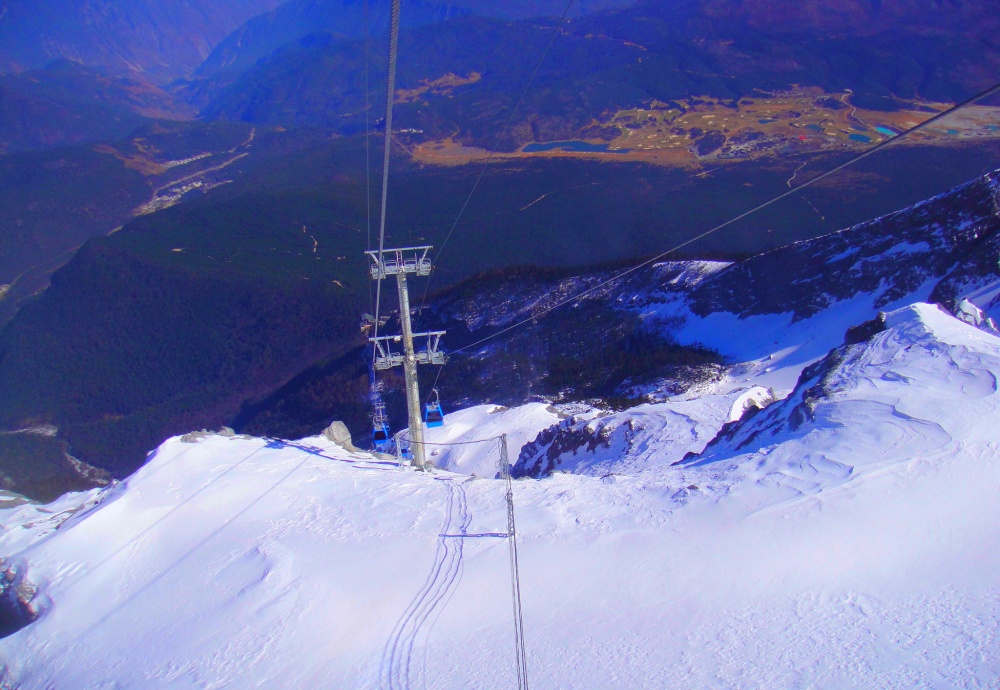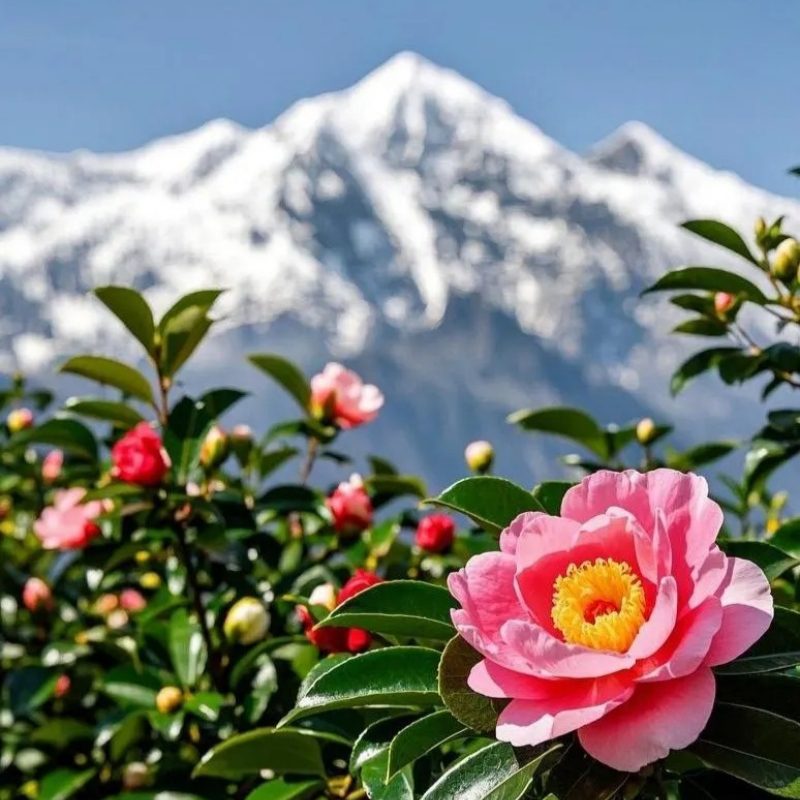
Climate
Yunnan has a generally mild climate with pleasant and fair weather because of the province’s location on south-facing mountain slopes, receiving the influence of both the Pacific and Indian oceans, and although the growing period is long, the rugged terrain provides little arable land. Generally speaking, Yunnan enjoys a mild climate with pleasant weather but, due to its varied terrain, the weather is also diverse in different regions.
Features of Yunnan Climate
Yunnan has the subtropical monsoon climate with large daily temperature difference and clear dry and wet seasons.
1. Temperature
The average temperature, in the hottest month(July) is 19℃-22℃, in the coldest month(January) is 6℃-8℃. On the same day, it is cool in the morning and evening, but hot in noon, especially in winter and spring, daily temperature difference can reach 12℃-20℃. With long frost-free period in the whole province, the southern border is frostless all year, the frost-free period is 300-330 days in the south, 250 days in the central area, and even the relatively cold northwest Yunnan and northeast Yunnan can reach 210-220 days.
2. Precipitation
The distribution of precipitation in the whole province is extremely uneven in seasons and regions. With distinct dry and wet season, the wet season (rainy season) is May to October, 85% of rainfall concentrates upon the rainy season, and the dry season is from November to the following April, the precipitation only accounts for 15% of the whole year. The regional distribution of precipitation in the province varies greatly, with the largest annual precipitation reaching 2200-2700 mm, and the least precipitation is only 584 mm. In most parts of Yunnan, the annual precipitation is in 1000 mm above.
3. Obvious Three-dimensional Climate
Yunnan with its complicated terrain has a varied climate. It is divided, from north to south, into three climatic zones — temperate, sub-tropical and tropical. Because of different climate distribution Yunnan from low to high terrain is also divided into over four regions- the low, hot river valleys ba zi (small upland plains), mountain areas, and frigid highlands. The climate zones and regions form a peculiar “three-dimensional” climate there.
Four Seasons of Yunnan and What to Pack
Spring(March – May)
During Spring, the temperature is 7-21℃. It ranges from 7–21°C (45–70°F) in Kunming, and from 5–17°C (41–63°F) in Lijiang and Shangri-La. So it is still chilly in early spring but the temperature starts rising. You can go to Kunming to see the blooming flowers which is called “spring city” or go to Luoping to appreciate the fields of yellow rapeseed flowers. Spring is also a season for Dali and Lijiang for its warm sunshine and blooming flowers.
April is a golden period for Yunnan travel due to its comfortable temperature and less precipitation.
What to Pack: Umbrellas and sunscreen are needed to prevent the strong ultraviolet rays. Also remember to bring a thick coat, because it was still very cold at night.
Summer(June – August)
Summer is the rainy season of Yunnan. There are many heavy rains and rainstorms. The precipitation in summer accounts for more than 60% of the year, so it is vulnerable to floods and waterlogging disasters. Compared with other cities in China, the summer in Yunnan is cool and a good place to escape the heat. The temperature difference is smaller that spring, but on rainy days, you can also have the feeling of winter. There is a local saying that it is winter when it rains. The temperature in summer of Yunnan is 23-25℃ (73-77℉).
During the early summer, it is also the best time to admire the highland scenery of Shangri-La. July and August are the peak season of Chinese summer travel.
What to Pack: When traveling to Yunnan in summer, remember to bring an umbrella, because summer is the rainy season, and you should pay attention to sun protection when going out. The ultraviolet rays here are very strong.
Autumn(September – November)
Autumn is another peak seasons for Yunnan travel due to its cool weather and less rain. The temperature ranges from 12–22°C (54–72°F). You can enjoy more sunny days in autumn and can appreciate the golden nature of Yunnan. You can go for hiking in Tiger Leaping Gorge and admire the golden scenery of Shangri-La. Or you can visit the red earth of Dongchuan, northeast of Kunming, and admire the colorful palette where different plants take on different shapes on the red earth.
Try to avoid the golden week of Chinese National Day(Oct.1-Oct.7), when there will be a large crowd in the tourist attractions and you can’t really enjoy yourself.
What to Pack: The temperature difference in the autumn is large, it is a bit cold in the morning and evening. When traveling to Yunnan in autumn, remember to bring a jacket and sweater. Umbrellas and sunscreen are needed to prevent the strong ultraviolet rays.
Winter(December – February)
There is no severe cold in winter with abundant sunshine, sunny days and less rain. The temperatures between the day and night differ greatly. It is warm during the day and it is cold at night. It’s more colder in the northwest of Yunnan such as Lijiang and Shang-La and warmer in the south and southwest such as Tengchong and Xishuangbanna. While winter in Yunnan is not freezing and there is much less rain. It’s a great time to enjoy the sunshine of Yunnan.
Try to avoid the holiday of Chinese New Year(in late January or early February), when there will be a large crowd in the tourist attractions and you can’t really enjoy yourself.
What to Pack: Winter is dry and there is no heating, so visitors who are afraid of cold should remember to bring down jackets to keep warm. Don’t forget to bring moisturizer, otherwise the skin will be chapped.
Yunnan Weather and Climate by Month
Best Time to Visit
If you had to pick a single province in all China that would expose you to the greatest variations in topography and climate, it would have to be Yunnan Province. There is an old and accurate saying here that “You can enjoy all four seasons on the same mountain, where each of these four season is only a few miles distant from the others.
So, the best time to visit Yunnan Province depends clearly on the region you like to visit. Yunnan is a very diverse province with the Himalayas in the north and subtropics in the south. Thus, there are also specific times of the year when it’s best to visit certain destinations.
If you’d like to visit Yunnan in winter, you should prevent to go north to Shangri-La or Deqin. During this time, the Yuanyang Hani Rice Terraces or Xishuangbanna(Xishuangbanna Tropical Botanical Garden, Menglun) would be recommended to visit though. Surely, if you would like to visit Haba Snow Mountain, Meili Snow Mountain, Jade Dragon Snow Mountain and other snow mountain, winter is a good time to Visit.
Generally speaking, the weather in most areas of Yunnan is mild in winter and cool in summer. If you like, It is suitable to visit Yunnan all the year round. Attractions, such as, Stone Forest, Dali Ancient Town, Lijiang Ancient Town, Cangshan Mountain, Erhai Lake, Jianshui Ancient Town…are available throughout the year. Besides, in order to escape the heat in summer, Lugu Lake and Fuxian Lake are recommended then.
Tips: Try to avoid the public holidays of China, such as May Day Holiday(May 1-3), National Day Holiday(October 1-7), Spring Festival Holiday(Usually early February), Qingming Festival(in early April), Dragon Boat Festival(in June).
Spring festival and national day festival are the most crowded time to travel. During these holidays, there will be a large crowd in the tourist attractions and you can’t really enjoy yourself. Flights and hotels can cost three times as much than usual, and it’s hard to get tickets during the Spring Festival.
Weather for Major Cities in Yunnan
- Baoshan Climate
- Chuxiong Climate
- Kunming Climate
- Dehong Climate
- Diqing Climate
- Honghe Climate
- Dali Climate
- Lijiang Climate
- Lincang Climate
- Nujiang Climate
- Pu’er Climate
- Qujing Climate
- Wenshan Climate
- Xishuangbanna Climate
- Yuxi Climate
- Zhaotong Climate

 7 Days GolfingTour
7 Days GolfingTour
 8 Days Group Tour
8 Days Group Tour
 8 Days Yunnan Tour
8 Days Yunnan Tour
 7 Days Shangri La Hiking
7 Days Shangri La Hiking
 11 Days Yunnan Tour
11 Days Yunnan Tour
 6 Days Yuanyang Terraces
6 Days Yuanyang Terraces
 11 Days Yunnan Tour
11 Days Yunnan Tour
 8 Days South Yunnan
8 Days South Yunnan
 7 Days Tea Tour
7 Days Tea Tour
 8 Days Muslim Tour
8 Days Muslim Tour
 12 Days Self-Driving
12 Days Self-Driving
 4 Days Haba Climbing
4 Days Haba Climbing
 Tiger Leaping Gorge
Tiger Leaping Gorge
 Stone Forest
Stone Forest
 Yunnan-Tibet
Yunnan-Tibet
 Hani Rice Terraces
Hani Rice Terraces
 Kunming
Kunming
 Lijiang
Lijiang
 Shangri-la
Shangri-la
 Dali
Dali
 XishuangBanna
XishuangBanna
 Honghe
Honghe
 Kunming
Kunming
 Lijiang
Lijiang
 Shangri-la
Shangri-la
 Yuanyang Rice Terraces
Yuanyang Rice Terraces
 Nujiang
Nujiang
 XishuangBanna
XishuangBanna
 Spring City Golf
Spring City Golf
 Snow Mountain Golf
Snow Mountain Golf
 Stone Mountain Golf
Stone Mountain Golf

















